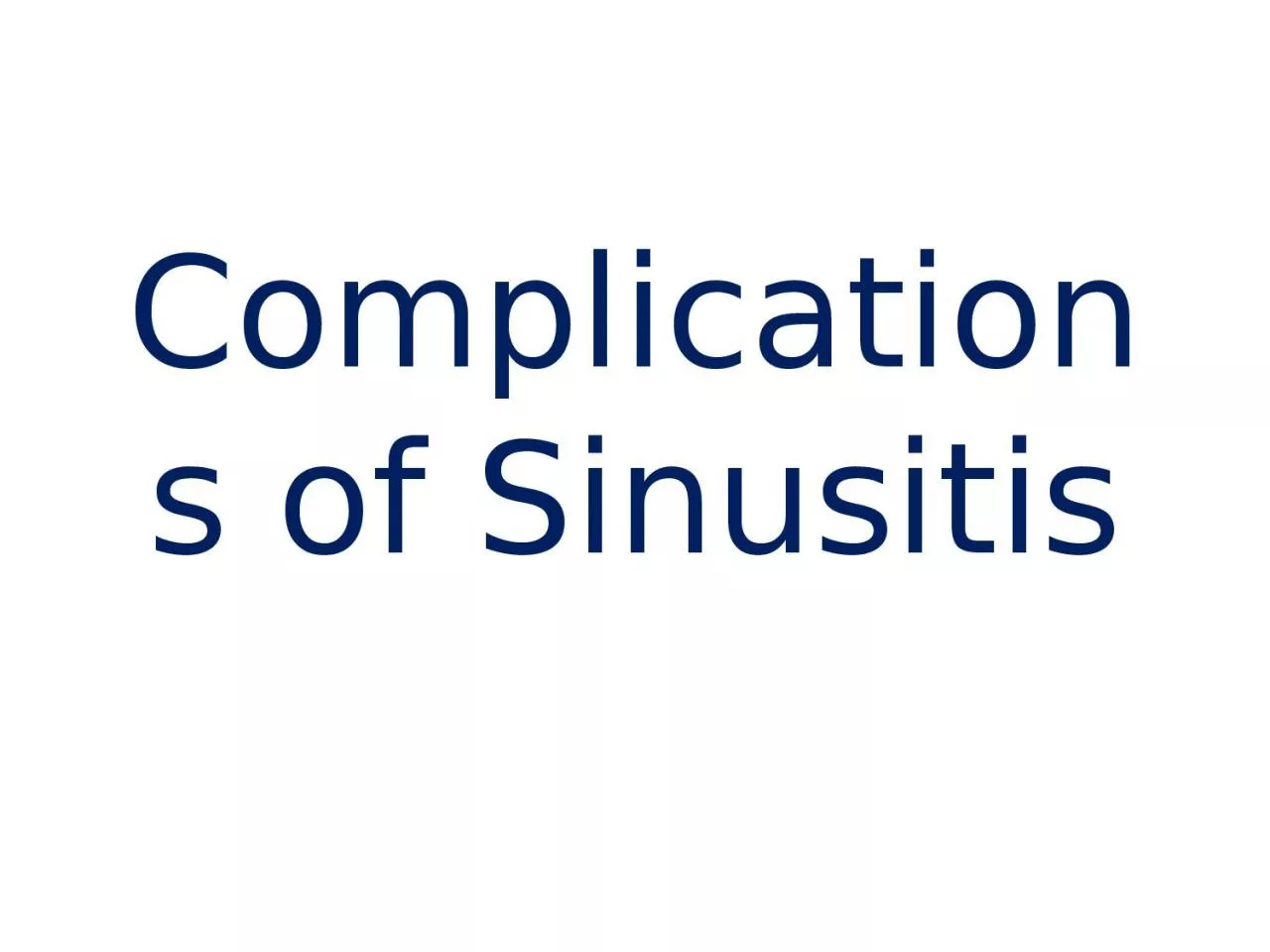

Three main categories Orbital 6075 Intracranial 1520 Bony 510 Radiography Computed tomography CT best for orbit Magnetic resonance imaging MRI best for intracranium ID: 1036949
Download Presentation The PPT/PDF document "Complications of Sinusitis" is the property of its rightful owner. Permission is granted to download and print the materials on this web site for personal, non-commercial use only, and to display it on your personal computer provided you do not modify the materials and that you retain all copyright notices contained in the materials. By downloading content from our website, you accept the terms of this agreement.
1. Complications of Sinusitis
2. Three main categoriesOrbital (60-75%) Intracranial (15-20%) Bony (5-10%) Radiography Computed tomography (CT) best for orbit Magnetic resonance imaging (MRI) best for intracranium
3. OrbitalMost commonly involved complication site Proximity to ethmoid sinuses Periorbita/orbital septum is the only soft-tissue barrier Valveless superior and inferior ophthalmic veins
4. Direct extension through lamina papyracea Impaired venous drainage from thrombophlebitis Progression within 2 days Children more susceptible < 7 years – isolated orbital (subperiosteal abscess) > 7 years – orbital and intracranial complications
5. Orbital ComplicationsChandler Criteria Preseptal cellulitis Orbital cellulitis Subperiosteal abscess Orbital abscess Cavernous sinus thrombosis
6.
7. Preseptal cellulitisSymptomatology Eyelid edema and erythema Extraocular movement intact Normal vision May have eyelid abscess CT reveals diffuse thickening of lid and conjunctiva
8. TreatmentMedical therapy typically sufficient Intravenous antibiotics Head of bed elevation Warm compresses Facilitate sinus drainage Nasal decongestants Mucolytics Saline irrigation
9. Orbital cellulitis Symptomatology Post-septal infection Eyelid edema and erythema Proptosis and chemosis Limited or no extraocular movement limitation No visual impairment No discrete abscess Low-attenuation adjacent to lamina papyracea on CT
10.
11. Facilitate sinus drainage Nasal decongestants Mucolytics Saline irrigations Medical therapy typically sufficient Intravenous antibiotics Head of bed elevation Warm compresses May need surgical drainage Visual acuity 20/60 or worse No improvement or progression within 48 hours
12. FeaturePreseptal CellulitisOrbital CellulitisProptosisAbsentPresentMotilityNormalDecreasedPain on motionAbsentPresentOrbital painAbsentPresentVisionNormalMay be decreasedPupillary reactionNormalMay be abnormal; ± afferent pupillary defectChemosisRareCommonCorneal sensationNormalMay be reducedOphthalmoscopyNormalMay be abnormal; ± venous congestion; ± disc edemaSystemic signs (e.g., fever, malaise)MildCommonly severe
13. Subperiosteal Abscess Pus formation between periorbita and lamina papyracea Displace orbital contents downward and laterally Proptosis, chemosis, ophthalmoplegia Risk for residual visual sequelae May rupture through septum and present in eyelids
14.
15.
16. Surgical drainage Worsening visual acuity or extraocular movement Lack of improvement after 48 hours May be treated medically in 50-67% Meta-analysis cure rate 26-93% Combined treatment 95-100%
17. Open ethmoids and remove lamina papyracea Approaches External ethmoidectomy (Lynch incision)is most preferred Endoscopic ideal for medial abscesses Transcaruncular approach Transconjunctival incision Extend medially around lacrimal caruncle
18. Orbital Abscess Pus formation within orbital tissues Severe exophthalmos and chemosis Ophthalmoplegia Visual impairment Risk for irreversible blindness Can spontaneously drain through eyelid
19.
20.
21. Incise periorbita and drain intraconal abscessSimilar approaches as with subperiosteal abscessLynch incision Endoscopic
22. Cavernous Sinus ThrombosisSymptomatologyOrbital painProptosis and chemosisOphthalmoplegiaSymptoms in contralateral eyeAssociated with sepsis and meningismusRadiologyPoor venous enhancement on CTBetter visualized on MRI
23.
24.
25. Intracranial complications
26. Occurs more commonly in CRSMucosal scarring, polypoid changesHidden infectious foci with poor antibiotic penetrationMale teenagers affected more than children
27. Direct extensionSinus wall erosionTraumatic fracture linesNeurovascular foramina (optic and olfactory nerves)Hematogenous spreadDiploic skull veinsEthmoid bone
28. MeningitisEpidural abscessSubdural abscessIntracerebral abscessCavernous sinus, venous sinus thrombosis
29. Fever (92%)Headache (85%)Nausea, vomiting (62%)Altered consciousness (31%)Seizure (31%)Hemiparesis (23%)Visual disturbance (23%)Meningismus (23%)
30. MeningitisHeadache,meningismusFever, septicCranial nerve palsiesSinusitis is unusual cause of meningitis, Sphenoiditis, EthmoiditisUsually amenable with medical treatmentDrain sinuses if no improvement after 48 hoursHearing loss and seizure sequelae
31. Epidural AbscessSecond-most common intracranial complicationGenerally a complication of frontal sinusitisSymptomatologyFever (>50%)Headache (50-73%)Nausea, vomitingPapilledemaHemiparesisSeizure (4-63%)
32. Lumbar puncture contraindicatedProphylactic seizure therapy not necessaryAntibioticsGood intracerebral penetrationTypically for 4-8 weeksDrain sinuses and abscessFrontal sinus trephinationFrontal sinus cranialization
33. Uncommon, frontal and frontoparietal lobesGenerally from frontal sinusitisSphenoidEthmoidsMortality 20-30%Neurologic sequelae 60%
34. Subdural AbscessGenerally from frontal or ethmoid sinusitisThird-most common intracranial complication, rapid deteriorationMortality in 25-35%Residual neurologic sequelae in 35-55%Accompanies 10% of epidural abscesses
35. SymptomatologyHeadachesFeverNausea, vomitingHemiparesisLethargy, coma
36. Lumbar puncture potentially fatalAggressive medical therapyAntibioticsAnticonvulsantsHyperventilation, mannitolSteroidsDrain sinuses and abscessMedical therapy possible if < 1.5cmCraniotomy or stereotactic burr holeEndoscopic or external sinus drainage
37. Intracerebral AbscessUncommon, frontal & frontoparietal lobesGenerally from frontal sinusitis, Sphenoid, Ethmoids Mortality 20-30%,Neurologic sequelae 60%Nausea, vomiting (40%)Seizure (25-35%), Meningismus , Papilledema (25%)
38. SymptomatologyHeadache (70%)Mental status change (65%)Focal neurological deficit (65%)Fever (50%)
39. Bony: Pott’s puffy tumorFrontal sinusitis with acute osteomyelitisSubperiosteal pus collection leads to “puffy” fluctuanceRare complicationOnly 20-25 cases reported in post-antibiotic era Less than 50 pediatric cases in past 10 years
40.
41. SymptomatologyHeadacheFeverNeurologic findingsPeriorbital or frontal swellingNasal congestion, rhinorrhea
42. ConclusionsComplications are less common with antibioticsOrbitalIntracranialBonyCan result in drastic sequelaeDrain abscess and open involved sinusesSurgical involvementOphthalmologyNeurosurgery